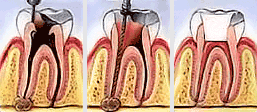
When bacteria penetrates the pulp chamber, nerve inside becomes inflamed. The sensitivity to hold and cold increases and toothache starts. In this case, do not delay visit to a dentist. First, toothache affects the quality of your life. Second, the infected tooth is very dangerous for your health in general.
Root canal treatment is sometimes referred to as “the removal of the nerve,” and many patients associate it with an acute pain. Because of that fear some people put off the visit to the dentist. And that is a myph! Modern treatment of root canals is practically painless process thanks to the quality of anesthesia and using of up-to-date materials and dental equipment.
Root canal treatment is carried out in the following cases:
- inflammation of the pulp of the tooth;
- increased tooth sensitivity to hot, cold
- swelling of the gums and / or change its color around the tooth;
- the emergence of the periosteal abscess
- pain in the gums in the area of the tooth;
- damage of the tooth due to an accident.
The sequence of root canal treatment
Local anesthesia is always used before treatment started. The dentist gets an access to the pulp by removing decay. Furthermore, he removes the inflamed pulp tissue (“nerve”) and disinfects the pulp chamber to remove the remaining bacteria and prevent further growth of the infection. X-rays are taken before, during and after the procedure. After drying the canal doctor fills the root canal with filling material – heated gutta-percha cones, which fills out all root canal system.
What happens if I don’t treat root canal?
Delay in treatment of the root canal is fraught with dangerous consequences. Inflammation of the pulp itself is a dangerous process and it can lead to such things as tumors of the jaw bone and inflammation of the gums. In rare cases extraction of the infected tooth and jaw surgery might be required.
Restoration of teeth
Restoration choice depends on the amount of destructed tooth structure. It can be restored with inlays, onlays or crowns.


